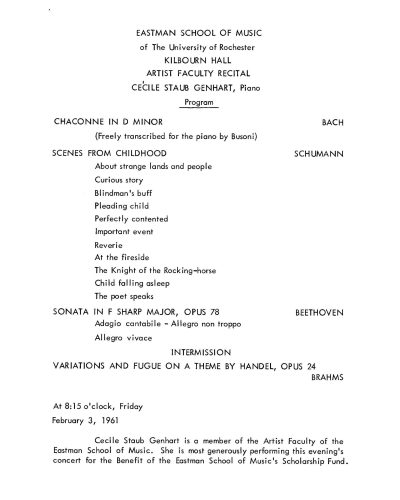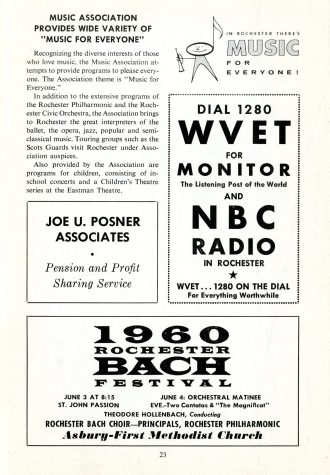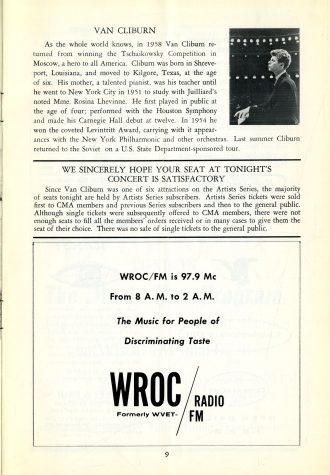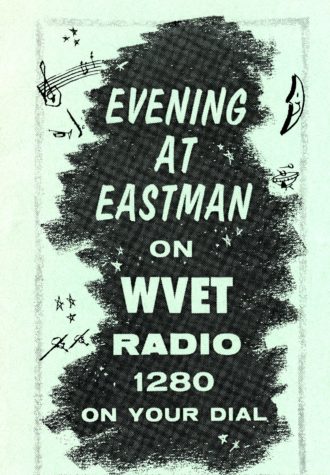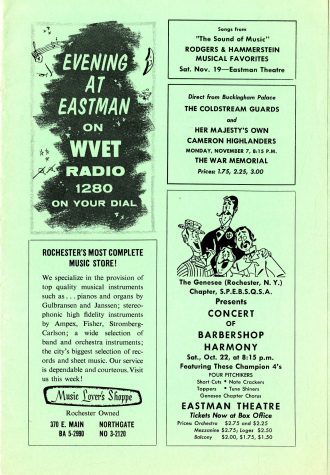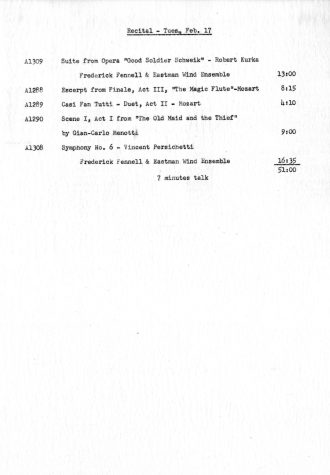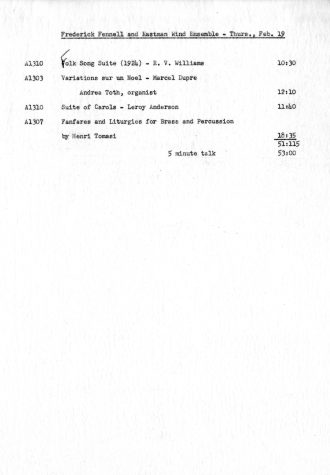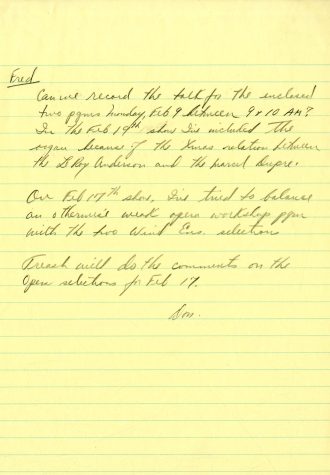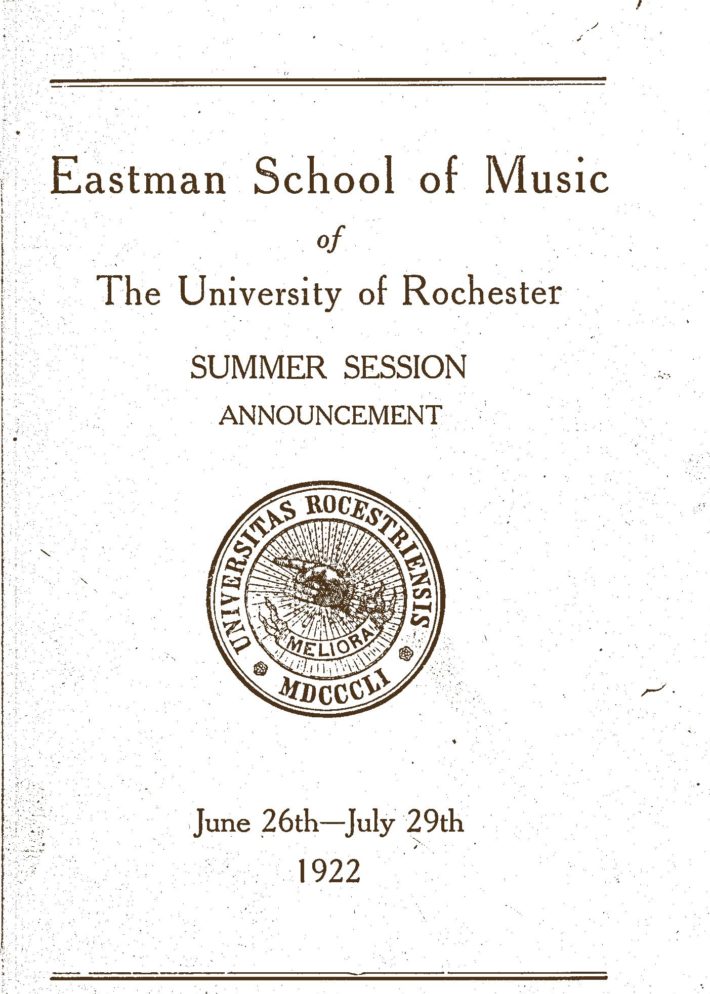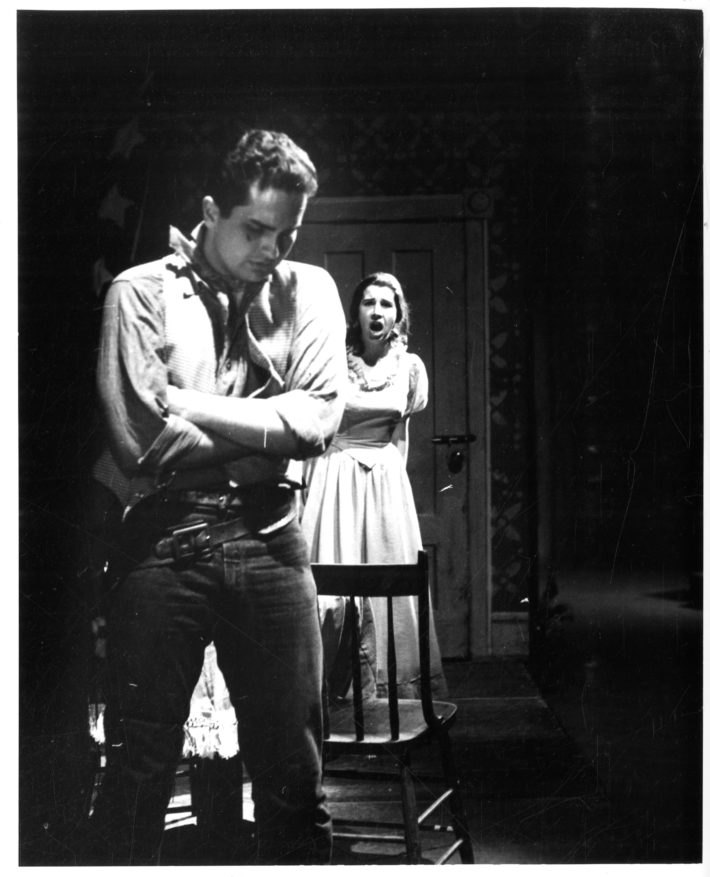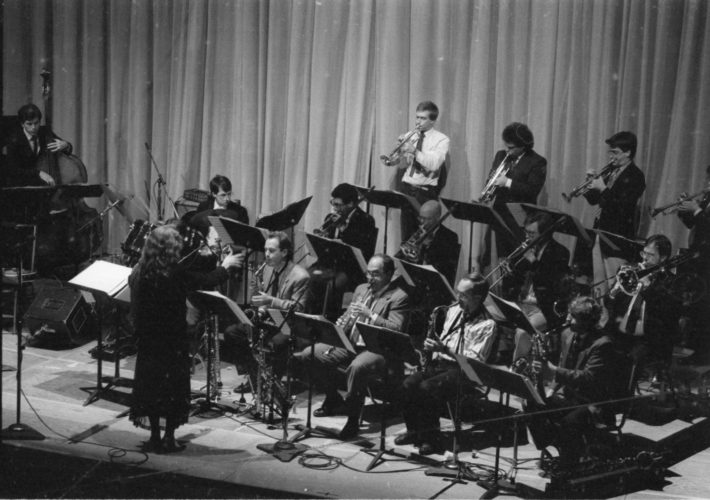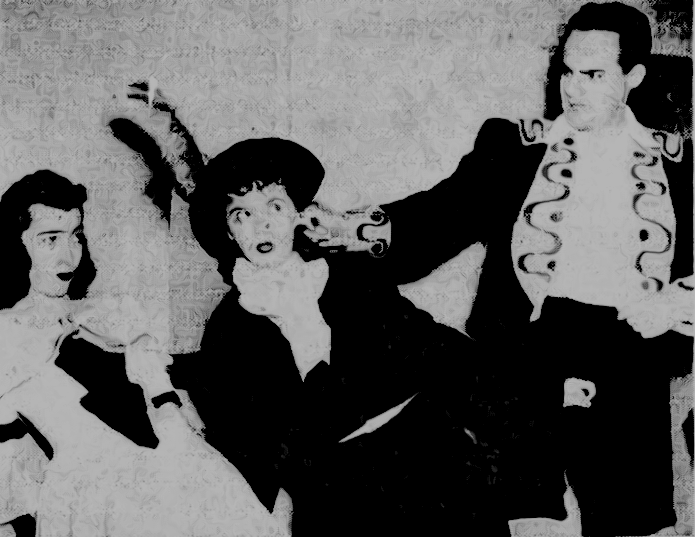Oct 3rd – 9th: ’Evening at Eastman’ makes its debut on the air
October 3, 20221958: ’Evening at Eastman’ makes its debut on the air
Sixty-four years ago this week, on the evening of Monday, October 6th, 1958, a new radio program comprised explicitly of Eastman School content made its debut on station WVET-AM in Rochester. Co-sponsored by the University of Rochester and the Veterans Broadcasting Company (WVET), “Evening at Eastman” was launched to be a nightly broadcast each weeknight from 9 pm until 10 pm. Documents in the Eastman School of Music Archives[1] confirm that “Evening at Eastman” represented a well-planned initiative to bring to the Rochester community the high-caliber music-making of the Eastman School of Music. Development of the program had been informed by a one-and-a-half-year study and evaluation of the feasibility and possibilities of such an endeavor. To mark the program’s launch, several community leaders expressed their support in public statements, including Mr. Ervin F. Lyke, President of Veterans Broadcasting Company (WVET), co-sponsor of the program; Dr. C. W. de Kiewiet, President of the University of Rochester; Mr. John Louther, President of the American Federation of Television and Radio Artists; and, Mr. Walter Lynch, President of Local 22, National Association of Broadcast Engineers and Technicians. In the words of WVET’s Ervin Lyke, “Evening at Eastman” represented a “new concept in radio programming” for the people of Rochester in that the entire performing forces of the Eastman School of Music would be brought to the airwaves and into the community’s homes and places of business and wherever locals happened to be tuning in.
In format, each “Evening at Eastman” nightly program consisted of selections of recorded music drawn from the master discs and tapes of Eastman School live concert recordings, supplemented by newly recorded commentary and conversation. All facets of performance were represented: large ensembles, chamber, solo instrumental and vocal, and operatic, featuring all of the Eastman School’s ensembles and many solo performers, students and faculty members alike. Responsibility for the program’s repertory was initially assumed by Director Howard Hanson, Professor Paul White (Conducting and Ensembles), and Professor Frederick Fennell (Conducting and Ensembles). Mr. Don Lyon, Director of Television and Radio for the University of Rochester, bore ultimate responsibility for programming.
To underscore, “Evening at Eastman” transmitted not music performed live in the moment, but instead, the previously made recordings of live performances, drawn from the collection that today we call the Eastman Audio Archive. As several writers have noted,[2] there had been live radio broadcasts from the Eastman School in earlier decades, beginning in 1922 via the newly established station WHAM, the apparatus of which was situated in the Eastman Theater. The first Eastman School event to be broadcast live was a Kilbourn Hall piano recital given by faculty member Raymond Wilson[3] on July 11th, 1922. In the following decade, beginning on January 7th, 1931, the Eastman School Symphony Orchestra under conductor Samuel Belov[4] was heard in a series of half-hour concerts broadcast weekly by station WHAM and carried nationally on the NBC network, believed to be the first occasion when any student orchestra had presented a regular series of broadcasts over a national network. In the spring of 1947, the NBC network resumed live broadcasts from the Eastman School with a series of fifteen programs of chamber music, featuring faculty members and students alike. There were still other live radio broadcasts besides these, all confirming the Eastman School’s lively presence on the airwaves by means of the new medium of radio.
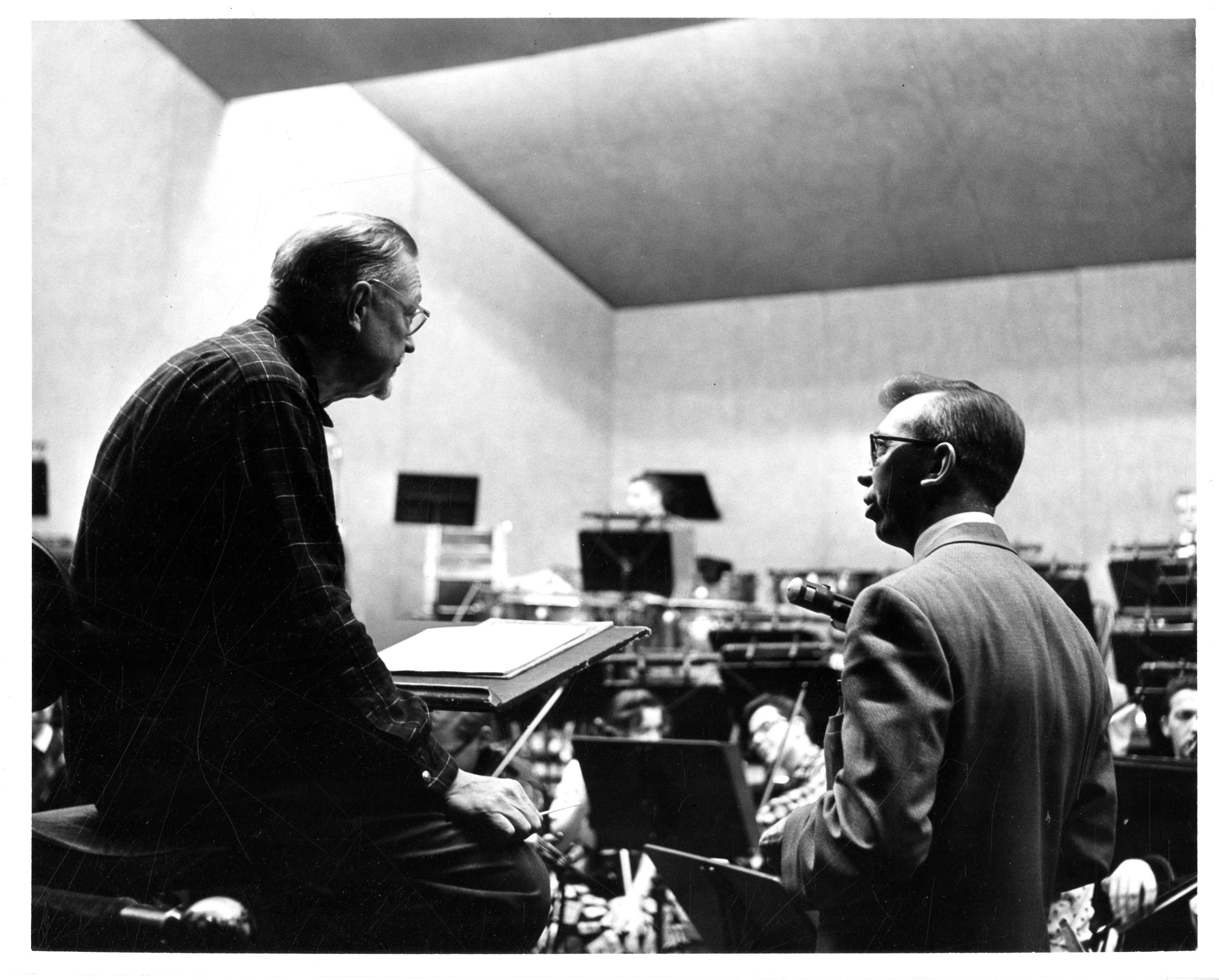
“Evening at Eastman” was on the air for at least four seasons, during which time a wide range of programming was presented, with students and faculty members receiving equal billing. The program’s debut on air was in the same month that the Eastman Philharmonia made its debut concert appearance, and from the very start, Hanson ensured that the Philharmonia received exposure. Among the other ensembles appearing on “Evening at Eastman” was Frederick Fennell’s Eastman Chamber Orchestra, a summertime ensemble comprised of faculty members and students performing together.[5] One sample program was the “Evening at Eastman” broadcast of March 24th, 1961, when the selections consisted of Pastorale by Tartini (performed by the ECO on July 17th, 1958, Sonata for flute, violin, and viola (performed on July 8th, 1958), and Concerto in B-flat major, K. 456 by Mozart (performed on July 24th, 1958), with soloist José Echániz.[6]
In the 1960-61 season, Howard Hanson’s American music interests were promoted on “Evening at Eastman” with a series under the title “History of American Orchestral Music” that spanned twenty-one program installments. The bulk of the content represented recordings by the Eastman-Rochester Symphony Orchestra, Hanson’s highly regarded recording ensemble that had been featured on recordings on the RCA Victor, Columbia, and Mercury Records labels. As Hanson had done in the concert hall, so he did on “Evening at Eastman”—that is, he lovingly presented to the audience not only the well-known audience favorites, but also many works heard less frequently. Thus, one program in that series featured works by Charles M. Loeffler and Charles Tomlinson Griffes, and another featured works by Herbert Elwell (these three not entirely household names in much of the nation). Still another program in Hanson’s “American Orchestral Music” series showcased pianist Eugene List[7], who was heard in George Gershwin’s Concerto in F and Rhapsody in Blue, with the chamber work The Winter’s Past by faculty member Wayne Barlow[8] placed between them. Hanson’s “History of American Orchestral Music” series received national recognition when the National Association of Educational Broadcasters selected it to be aired over its radio network.
In addition, there was a periodic “Meet the Faculty” feature on “Evening at Eastman” with focus on one particular faculty artist at a time. The broadcast of October 27th, 1961 profiled pianist Cecile Staub Genhart[9], featuring three works that Mrs. Genhart had performed in a Kilbourn Hall recital earlier that year on February 3rd, 1961: the Bach-Busoni Chaconne in D minor, Scenes from Childhood by Robert Schumann, and the imposing Variations on a Theme by Handel by Johannes Brahms. (In her Kilbourn Hall recital she had also performed Ludwig van Beethoven’s Sonata in F-sharp major, opus 78, which was not included in the “Evening at Eastman” broadcast.)
The letters of appreciation that Dr. Hanson received from listeners in the local community bear witness to the Rochester community’s satisfaction and enjoyment. Although “Evening at Eastman” did not remain on the air for an appreciably long length of time, it represented a first-of-its-kind broadcasting venture in Rochester, and one by which the Eastman School presented a diverse audio profile of itself to the outside community. Other initiatives involving the Eastman School on the air will be featured in future “This Week at Eastman” entries.
►Printed advertisements for WVET and WROC, two of Rochester’s radio stations, which appeared in local concert programs. Both of these stations bore responsibility for transmission of “Evening at Eastman” between 1958 and 1962. In the 1961-62 season the Veterans Broadcasting Company purchased WROC-TV/FM. Besides the migration from callsign WVET to WROC, “Evening at Eastman” underwent another major change during its run, which was the change in time slot from 9pm/10pm to 7pm/8pm.
► Publicity for “Evening at Eastman” took the form of printed advertisements in local concert programs and in other publications, such as is seen here; in addition, the weekly program listings were published in the Rochester press at the start of each week. Eastman School concert program file.
► Among Frederick Fennell’s papers are some samples of “Evening at Eastman” programs. The two programs shown here are accompanied by a note to Dr. Fennell from Don Lyon, Director of Television and Radio for the University of Rochester, who bore ultimate responsibility for the programming. Frederick Fennell Papers, accession no. 993.9.
[1] Primarily in the Howard Hanson Collection (accession no. 997.12), the Frederick Fennell Papers (accession no. 993.9), the Rochester Scrapbooks, and the Local Ephemera vertical file.
[2] The content in this paragraph was informed by the writings of Charles Riker (1948), Blake McKelvey (1970), and Vincent Lenti (2021), and by Eastman School printed concert programs which bore indication of radio broadcast whenever applicable.
[3] Raymond Wilson (1888-1969), American concert pianist and teacher; served on the faculty of the Eastman School (1921-1953), where he was also Director of the Preparatory Department (1935-1953).
[4] Samuel Belov (1884-1954), Russian-born violinist and violist; served on the faculty of the Eastman School (1921-1949), where he taught his two instruments and also conducted one of the student orchestras.
[5] Frederick Fennell originated the Eastman Chamber Orchestra and served as its music director each summer for nine seasons (1954 through 1962). The ECO concert of July 26th, 1962 was the occasion of Maestro Fennell’s last bow at Eastman before departing for his new post at the Minneapolis. Symphony Orchestra.
[6] José Echániz (1905-1969), Cuban-born concert pianist, conductor, and teacher; served on the Eastman School faculty, 1944-1969. He was especially known for his interpretations of Spanish and Latin-American repertory.
[7] Eugene List (1918-1985), American concert pianist and teacher; served on the faculty of the Eastman School of Music, 1962-1975. While serving in the United States Army Mr. List had had the distinction of performing for assembled leaders Winston Churchill, Joseph Stalin, and Harry Truman at the post-War World II Potsdam conference in 1945.
[8] Wayne Barlow (1912-1996), American composer and teacher; served on the faculty of the Eastman School of Music 1937-1978. While he composed dozens of works in various genres and for diverse performing forces, his most frequently performed work has remained The Winter’s Past, scored for oboe with chamber ensemble.
[9] Cecile Staub Genhart (1899-1983), Swiss-born concert pianist and teacher; served on the faculty of the Eastman School of Music 1928-1971, 1973-1983. She was known as a staunch advocate for the methods of English pianist-pedagogue Tobias Matthay.

